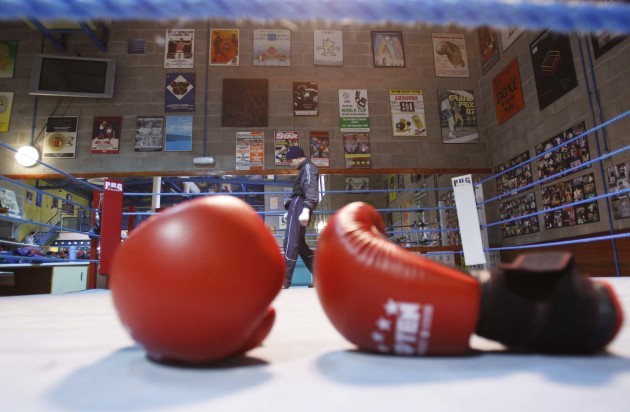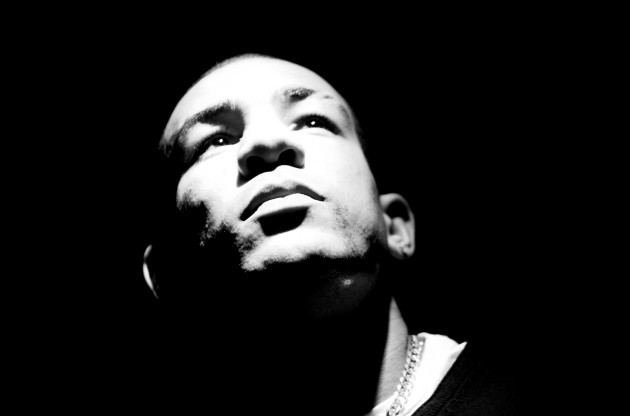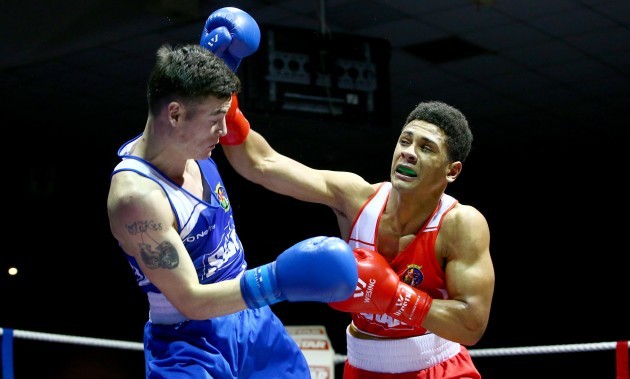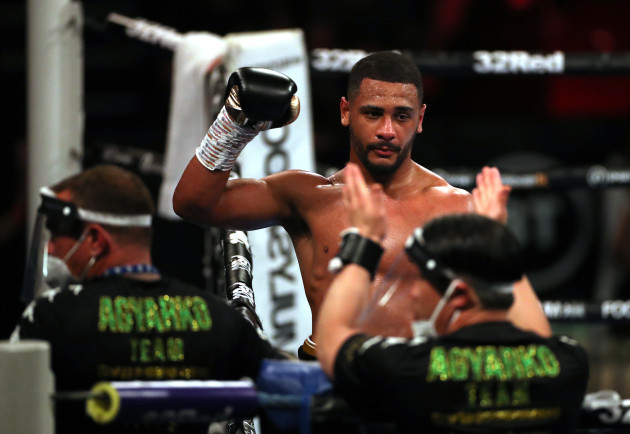THERE IS A difference between a moment that changes a person’s life and a moment that defines a person.
Caoimhín Agyarko was 20 years old when he was almost robbed of the opportunity to contemplate that difference.
Agyarko was out with his new girlfriend, Caoife, on the night of 1 May 2017 in their hometown of Belfast. They decided to pop to McDonalds before making tracks for home.
After an argument with a group of young men over a thrown cup, the contents of which spilled all over himself and Caoife, Agyarko was slashed in the face by somebody carrying a Stanley knife, leaving a six-inch wound.
If the blade had traveled just over an inch further, it would have severed an artery and killed him in seconds. Agyarko was rushed to hospital for specialist treatment and facial surgery.
In the four and a half years since, nobody has ever been charged for the crime.
What was done to Agyarko would change anybody’s life but much of the psychological torment he endured in its aftermath centered on the fact that he was an extremely talented amateur boxer, by that stage a five-time Irish champion through the age grades.
His sense of self as a confident, unarmed combatant was, for a time, shattered, and he subsequently developed depression.
But that incident was never going to define Caoimhín Agyarko, as is partly evidenced by the fact that the following year, he won his sixth Irish title — this time the big one, as a senior — and then embarked upon a professional career in which his CV remains spotless; and by the simple reality that he gets incrementally better at dealing with it every day of his life.
Dangerous man if I do say so my self 😤@stnsports_ @PaulReady pic.twitter.com/5kfFj1fGL3
— Caoimhin Agyarko (@caoimhinagyarko) October 4, 2021
Agyarko was one of three children born in Croydon, London to an Irish mother, Rosaleen Hynes from Belfast, and Ghanain father, Atta Agyarko. His parents split up when he was a toddler, soon after the birth of his younger sister, Summer.
Rosaleen moved back to Belfast with Caoimhín, Summer and their brother Eoghan in the mid-2000s. Caoimhín was seven. The kids always remained close with their dad, although seeing him far less regularly took some getting used to.
Even more jarring, though, was moving into the heart of West Belfast as “three mixed-race kids with English accents,” Agyarko laughs. “Which wasn’t, kind of…ideal.
“It was only nine years prior that the Good Friday Agreement had been signed so things were still pretty fresh in the memory,” he says. “Now, we often flew over with our mum when we were younger anyway — we’d go to Turf Lodge where my Granny’s house was, so everyone there knew us as a family anyway… It wasn’t too bad.
But being mixed-race kids… There were bits and pieces of racism but it wasn’t like I was bullied every day or anything. You’d get the odd comment — and listen, you’d still get it nowadays from small-minded people — but not a lot. I actually probably faced more racism growing up in England than I got in Ireland. And when we got to Ireland, then, it was more so that I got abuse for being English! And that was a bit mad because I’ve never really considered myself to be English, or British, or anything like that: I’ve always considered myself to be Irish, d’you know what I mean? So, whenever we’d called ‘British bastards’ — ‘Go home, British bastards‘ — and stuff like that, although it wasn’t nice, we didn’t really take offence to it because we were Irish.
Not long after they landed into Belfast indefinitely did Rosaleen bring her boys across to the legendary Holy Trinity club, which sits directly across the road from their Granny’s house. Unlike the usual trope, however, Caoimhín and Eoghan weren’t dragged down to the local gym to have a bit of ‘discipline’ knocked into them or anything of the sort, but instead simply to see first-hand where their uncle Jim used to practice his own sporting discipline some years beforehand.
Well, at least that’s what they were told… Caoimhín did harbour a bad temper in his early years and, as a perceived outsider, ‘a Brit’, or simply because he was new to the area, he was rarely want for a footpath scrap.
“I think it was incidental but maybe our mum did think boxing would be good for me and my brother, I don’t know. I’ve never, ever had this conversation with her. What I would say is that she didn’t push us into boxing.
“We were always brought into certain sports like football, Gaelic and stuff like that by my mum, so maybe it was her plan. But I’d say it was more an accident; she was genuinely just showing is where our uncle used to box — and then me and my brother put gloves on and it just took off from there.”
Be it by design or something divine, Agyarko revelled in the opportunity to unleash some of his childhood “anger” in the controlled confines of one of boxing’s most storied gyms, particularly as he got a bit older and began to pay more attention to the technical intricacies of the sport.
Holy Trinity and especially its legendary head coach Mickey Hawkins — a trainer, career advisor and father figure rolled into one — got Agyarko out of trouble in school and kept him out of trouble in life.
Agyarko was finally ‘home’.
A couple of hours down the M1, then, he found a boxer with whom he could especially identify, a mixed-race Irish kid who was tearing up trees on both the domestic and international circuits.
“I was a huge fan of Darren Sutherland’s,” says the 24-year-old. “I remember seeing him boxing in the National Stadium and watching him box at the Olympics (Beijing 2008).
I caught glimpses of his career and when he passed, I did a lot of research on him. Seeing someone like Darren, it kind of gave me a bit of hope — especially seeing him going to the Olympics and getting a bronze medal, and turning pro and doing so well early on. Being of the same skin colour — he was mixed-race too — it gave me that confidence in myself that I could achieve something in boxing regardless of where I did originally come from. He was that kind of figure that I could look up to in the boxing game.
“And then, obviously, you had Tommy McCarthy, who’s from Belfast the same as myself,” Agyarko adds. “But after Darren passed, I got to know the sport a bit better, I came to realise there were things in the sport that I wanted to achieve. And in Darren and Tommy, I had role models who had done some of those things. Looking up to Darren in those early years gave me that kind of confidence where afterwards, race never really came into my thinking.”
When he was as young as 12, Agyarko would sit in front of an old computer studying grainy footage of Muhammad Ali, Floyd Mayweather, and Mike Tyson on this new thing called YouTube — but as well as their fights, he studied the minutiae of their training: the drills they used to improve their head movement, their hand speed, their footwork, he would attempt to replicate in the gym.
That appetite to learn — combined with natural athleticism and bazookas for arms — culminated in his being permitted to train alongside the senior boxers at Holy Trinity by the age of 14. Agyarko won his first Irish Schoolboys title that same year.
He was Irish champion four more times through his teens, representing his country at underage European and World Championships.
Ultimately, the Rio 2016 Olympic qualification process came too soon for Agyarko at 18 — both in terms of his limited senior experience and because he was physiologically caught between a rock: welterweight (69kg); and a hard place: middleweight (75kg).
He had always suspected he would one day blossom in the less refined environs of the professional game but in 2016, he mapped out for himself two final years in the amateur vest. His primary goal was to qualify for the Commonwealth Games in Gold Coast, Australia, in 2018. But either way, he would turn over to the paid ranks that year.
In the middle of this plan, however, his whole world was turned on its head.
On 1 May 2017, Agyarko and his new girlfriend Caoife attended a charity boxing event and, later, the famous Belfast nightclub, Thompson’s, near City Hall. They fancied a nibble before hitting the road for home. They headed for McDonald’s on Royal Avenue.
While they were in the queue outside, a plastic cup launched from some distance left Agyarko and Caoife soaked.
Agyarko, who doesn’t drink, strolled back down the queue, asking who had thrown the cup. He was pointed in the direction of a large group of young men, whom he verbally confronted. The ensuing back-and-forth fizzled out at first and Agyarko walked away. But when the tension resurfaced moments later, the argument turned physical.
Agyarko was first blindsided by somebody who hit him over the head with a glass bottle, knocking him to the ground. He got back up and chased the person who had struck him. After that, things get a bit blurry.
The next thing that he can recall clearly is that Caoife was hauling him off somebody, alarmedly asking him what had happened to his face.
Agyarko had been slashed with a knife, leaving a deep gash from his left cheek to his jawline. The PSNI arrived on the scene and he was whisked away in an ambulance, initially against his wishes: he wanted to first make sure Caoife got back to the safety of Thompson’s, where her brother worked.
It was only when the ambulance crew informed him that they were going to bypass Belfast’s three city-centre hospitals and bring him directly to Ulster Hospital for specialist treatment that he realised things were pretty serious.
Agyarko later learned that his phone and wallet were gone, but this was small beer in comparison to being informed that the blade was about an inch away from causing him to bleed out within seconds.
Critically, the stabbing took place on the far side of a pillar from the only CCTV camera that would otherwise have had a full view of it. Nobody has ever been caught for what they did to him.
“It’s something that will live with me for the rest of my life regardless of how much I try to not think about it or try to overcome it,” Agyarko says.
“I’ve got a scar down my face — it’s six, seven inches long so I wake up every morning, look in the mirror, and that just reminds me of it.
“I look at it as a blessing that I’m still here and it has taught me a lot of things in life, about how strong I am, about survival.
“But listen, it does affect me mentally sometimes. I get better with it 1% at a time. I do still struggle to sleep, I do still have sort of trauma from it. I know it’s not going to just go away, it will take time.”
During the post-traumatic months, the first four of which were spent physically recovering, Agyarko developed depression. He couldn’t box. He struggled in crowds. By night, he suffered from constant, vivid nightmares. By day, his mind was besieged with suicidal thoughts.
These were in time banished only by acknowledging them out loud — and speaking especially to Caoife, with whom he remains in a relationship four years later.
“The things that I struggled with were… The fact that I actually got stabbed — it’s just not a thing that you ever think is going to happen to you,” he says. “The experience in hospital, having to go through blood transfusions and knowing that if it had happened an inch lower, I would have bled out in 12 seconds.
But I think what I struggled with most was the unknown: I still don’t know who did it… I could be walking past this person in the city centre — even exactly where it happened, or in a nightclub or somewhere — and they know me because I was all over the news, I’m the mixed-raced kid that they did it to and there aren’t too many mixed-race people in Belfast, and it’s been brought up with me becoming a professional boxer and developing a profile since. They know exactly who I am but I don’t know them. What’s stopping them from doing it again?
“It was also the fact that I was with my girlfriend on our own and there were 30 of them’nes. So, to not only attack me while I’m outnumbered but to then use a weapon… And the feeling afterwards is like, ‘Why me? Was it because I’m black? Was I just unlucky?’ And on top of that, I was actually hit with a bottle first. I had never been dropped in my life — in the ring or in the street — but I got hit with a bottle, got dropped, and then I wind up getting stabbed while being attacked by 30 people.
“That man in me,” Agyarko adds… “That pride… Especially as a fighter, you have that ‘macho man’ in you, you feel like you’re invincible. To then get stabbed…
I felt like I had been violated. Something like that has never happened to me before: being violated, attacked, and not being able to get revenge. That always played on my mind. That was something I had to overcome: the pride, the ego. I had to let a lot of things go. I think the hardest part was not getting revenge. I knew that if I sought revenge, I would have ended up in jail.
“It was either go left or go right and I took the right path and continued on with my boxing career, and I didn’t let it affect my boxing career.
“I kind of used it to my advantage mentally.
I never wanted to be known as the fighter who got stabbed — I wanted to become known as a great champion. That drives me to train as hard as I possibly can, to be successful in this boxing game — so that I’m not remembered by that incident, but that I’m remembered just as a great fighter.
“And listen, I know it’s a part of my story and it’s made me who I am today. It was always those headlines, you know? ‘Boxer who got stabbed…’ I just don’t want to be defined by it.”
Remarkably, that very boxer returned to competitive boxing action in September 2017, his face still tender as the nerves around the repairing wound kicked back into gear.
He eventually missed out on qualification for the the 2018 Commonwealths, however, and were it not for the intervention of Holy Trinity trainer Mickey Hawkins, he would have turned pro immediately as he had intended for the past two years.
Instead, Hawkins managed to convinced Agyarko to remain amateur for another few months and to pursue an Irish Elite title. Agyarko did so, becoming national senior champion for the first time in February 2018, up a division from his preferred weight. He was subsequently recruited by Italia Thunder to compete in the highly prestigious World Series of Boxing, ostensibly a pro-am competition.
In what was officially his final bout as an amateur, he earned an eye-catching stoppage victory.
Agyarko not only ticked off two boxes on his amateur bucket list but he also earned himself a far weightier professional contract in the process. A month after he wet promoter Frank Warren’s paperwork, he made his paid bow live on BT Sport.
Nicknamed ‘Black Thunder’ and boasting a record of 9-0(6KOs), middleweight Agyarko is currently considered one of the leading prospects in Ireland or Britain. Things have come full circle in a sense in that while he still lives in Belfast, he trains back in London — at the iBox Gym back in Bromley with coaches Al Smith and Eddie Lam.
While still promoted by Warren, Agyarko recently signed a management deal with STN Sports, a relatively new fixture on the career-guidance scene but crucially one which boasts a co-founder in Paul Ready who, for five years prior, was chief matchmaker at Eddie Hearn’s Matchroom. Ready started STN (Second to None) with his friend, Sean O’Toole, a lawyer. His career expertise in identifying that sweet-spot level of opposition for his fighters will stand Agyarko in good stead as he enters the next phase of his pro career.
It’s exactly what he needs, in truth, after ploughing through his two most recent opponents without much fanfare and finding himself at a frustrating juncture in his career.
“The business side of boxing can be pretty sickening,” Agyarko says. “There are fighters in the UK at the moment who are being kept away from me because they sell a lot of tickets — which I understand, but it’s also crazy.
“People always say to me, ‘When are you gonna step up? When are you going to have these meaningful fights?’ And with me right now, it’s about finding that balance, too. I’m ready for a certain stage that I haven’t yet fought at; I’m ready to prove that I’m at that stage before jumping onto the next stage, if that makes sense.
I’ve got potential opponents turning the fight down, people who are 15-0; former British champions, Commonwealth champions, world-title challengers… So it’s kind of a case of, ‘What level am I at, then?’ Because they’re turning a fight down and if I can’t get fights against the likes of them, then who do I fight next? Because I also don’t want to be thrown in at the very deep end too soon!
“With Paul and STN, I feel we will find that balance and get those right fights at the right time.”
Agyarko mulls over an invitation to name names and call out some of the fighters who have made themselves scarce, but takes the high road.
“D’you know what? I won’t. I know who they are and they know who they are”, he laughs.
“And at this stage, I know some of those fights simply won’t happen because they haven’t just turned it down once — it’s been twice, three times where they’ve knocked it down. And it’s crazy who some of them are. Some people would be asking am I ready for them, you know?”
‘Black Thunder’ is currently in the early stages of a camp in London, awaiting confirmation of his next fight date.
That his partial relocation allows him to spend training-camp downtime with family in the English capital — including his father, Atta, with whom he remains close — can take the edge off any loneliness: eight to 10 weeks is a long time to be separated from Caoife, friends, and his family back home — which now includes a little nephew.
But while away for work, Agyarko prefers to mostly close himself off from the wider world during the week, catching up with loved ones over the weekend.
He is acutely aware of the likelihood that solitude in London contributed significantly to the tragic death of one of his heroes, Darren Sutherland, in 2009, and he has battled his own very different demons, of course. But Agyarko has in recent years put significant effort into understanding and maintaining his own mental health, an extension of his long-running fascination with the human mind generally. (He has been using a mind coach of late, but became interested in performance psychology even before working with Dublin footballer Kevin McManamon while part of the Irish team as an amateur).
He is a man who has found relative peace outside of the ring and now, Caoimhín Agyarko is craving a few wars within it.
“When times get tough and you’re feeling a bit sorry for yourself, you don’t have a fight date, you’re missing people at home… I always just remind myself of why I’m doing this. Like, I chose this! No one is forcing me to do it — it’s entirely my decision.
“It’s the end goal that drives me every day. I know where I want to be in five, six years’ time. I want to retire by the time I’m 30 and I want to retire having become the first black Irish world champion, having achieved something in the sport that I’ve given my whole life to and that has given me so much. And while I don’t ever look too far beyond a given fight, I always know what the end goal is.
“Becoming the first black Irish world champion is about creating history.
“First and foremost, I’m a proud Irishman — regardless of my skin colour.
I understand the significance of becoming another world champion for Ireland, and in keeping Belfast boxing on the map and even taking it further. But in doing so, I can also give hope to other kids who are not only mixed-race or black, but just people generally who come from different countries to live in Ireland; let them know that no matter where they come from, they can achieve something and be proud of where they come from while also representing Ireland on the highest stage.
“I want to remind people that wherever you come from or whatever you’ve been through, you can achieve whatever you set out to achieve.”







